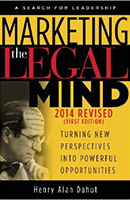 VERDICT: Touchdown!
VERDICT: Touchdown!
The Copyright Book: A Practical Guide
By William S. Strong (Cambridge, MA: MIT Press, 6th ed. 2014). 496 pgs. $22.19. Order, www.amazon.com.
Reviewed by Kristen E. Knauf
Copyright law has never been more important than it is today. I might be partial because I practice in this field, but think about it: we collectively spend countless hours each day being entertained by creative programming broadcast on television or streamed over the Internet. We listen to music, and whether we listen via CDs, MP3s, or digital radio over the Internet, everything depends on copyright – both for the content of the songs and the software that delivers them. The tools we use at work and at play are creatures of copyright in one form or another.
When I first started reading The Copyright Book: A Practical Guide, I was skeptical that the author could meet the tremendous challenge of surveying the wide world of copyright law in a single handbook. I am delighted to report that my skepticism was without merit. The 13 chapters walk the reader through a straightforward summary of fundamental topics such as copyright ownership, transfers of copyright, registering a copyright claim, subsidiary rights, compulsory licenses, infringement and popular defenses (including the famous fair-use defense), and international aspects of copyright law.
Want to Review a Book?
Please request a book and writing guidelines from Wisconsin Lawyer managing editor Karlé Lester, at klester@wisbar.org or (608) 250-6127. Reviewers may keep the book reviewed. Reviews of about 500 words are due within 45 days of receiving the book. Reviews are published, space permitting, in the order received and may be edited for length and clarity.
The fact that the book is now in its sixth edition should have also eased my concerns. The newest edition covers recent hot topics such as the defeat of the Stop Online Piracy Act (SOPA), file sharing, and the latest developments under the Digital Millennium Copyright Act (DMCA).In the process, the author seizes the opportunity to share his views about the evolution of the law and the sometimes awkward handling of copyright dilemmas in Congress and the courts. He also offers practical insights about copyright law and sets the stage for many healthy debates on the various areas affected by copyright protection, from fair use to technological growth.
I highly recommend this book not only to the authors and other artists who create copyrighted works but also to individuals who use copyrighted works in their professions (for example, teachers and librarians) and to anyone with an interest in how copyright law affects his or her everyday life. Although the author claims that the book is written for nonlawyers, the plain-English explanations as well as the useful appendices make this the type of treatise that could be a handy resource in law offices everywhere.
Kristin E. Knauf, Marquette 2010, lives in Dallas, Texas.
 VERDICT: It’s a Keeper
VERDICT: It’s a Keeper
Marketing the Legal Mind
By Henry Alan Dahut (LMG Press, rev. ed. 2014). 244 pgs. $21.62. Order, www.amazon.com.
Reviewed by David Purcell
Like many other industries (including music and entertainment), the legal profession has been profoundly affected by innovations in technology and communication. Specifically, in addition to the professional responsibilities owed to their clients, lawyers and firms must now address their clients’ customer service expectations as well as their firm’s public relations, vision, and organizational structure in the digital age.
In Marketing the Legal Mind, author Henry Alan Dahut, a lawyer, encourages readers to consider other approaches and perspectives to the practice of law and firm-building. An immediately apparent attribute of Marketing the Legal Mind is that rather than focusing on the minutiae of practicing law, Dahut encourages the reader to consider her or his approach to other big-picture areas, including the client experience, firm organization, leadership, team-building, vision, and charters (for example, mission statements).
In today’s world, storytelling content-driven marketing is pervasive. So while narrative marketing attracts the consumer (in the legal profession, the “client”), does the message define the firm?
On this note, Dahut reminds readers that in addition to attracting clients, firms must be aware of the “bigger” message that they are sending. In particular, he notes the effects of
(legal) advertising initiatives that include hyperbole: specifically, fear- and greed-based advertising or PR campaigns.
Dahut then segues from marketing considerations into individualized approaches (philosophies, if you will) to the practice of law and interactions with clients and builds from there – touching on areas related not only to the idea of reinventing one’s firm/practice but also to issues of firm structure, team-building, leadership, and business development.
Although not explicitly stated, arguably one of the biggest takeaways of Marketing the Legal Mind is straight out of a marketing 101 course (and may remind us of our undergraduate years) – the importance of the alignment (and synergy) between one’s marketing approach, planning, strategies, and goals and objectives.
Although Marketing the Legal Mind isn’t required reading for everyone, it certainly should be considered for inclusion on a list of suggested resources for a firm retreat – it can serve as a helpful resource and checklist on a variety of concerns, including business development, marketing, branding, and organizational and leadership structure.
While this book won’t provide any instant solutions, or turn us into marketing mavens, it is a good introduction to the realities that various industries face with regard to marketing and customer service in the digital age. It is also a timely reminder that there is a lot more to the practice of law in the digital age than one’s legal acumen and professional network. The book is an excellent complement to any firm’s vision, mission statement, and organizational and leadership approach.
David Purcell, U.W. 1999, earned a bachelor’s degree in music from Berklee College of Music. He is a musician, industry professional, and educator and teaches at Columbia College Chicago and Berklee College of Music’s online division, Berklee Online.
 VERDICT: It’s a Keeper
VERDICT: It’s a Keeper
The Dark Side of Nursing
By Ingrid Teresa Pryde (Bloomington, IN: Balboa Press, 2014). 304 pgs. $17.30. Order, www.amazon.com.
Reviewed by Stacy A. Broman
The Dark Side of Nursing explores Ingrid Teresa Pryde’s nursing career in Australia, during which she was subjected to various forms of workplace bullying, including abusive phone calls and confrontations with superiors. The author describes bullying as perpetrated by nurses safely hidden behind the mask of a “helping profession.”
Much of the book describes a particular incident at a small beachside hospital where Pryde was working two days per week running a chronic disease program. She was behind on paperwork and was bullied by her supervisors. The book describes harassment, trauma, and stress allegedly caused by bullying. The author left the position at the beachside hospital and moved to Saudi Arabia to be a charge nurse, leaving her husband and children in Australia.
The book is well documented with 12 pages of references, including citations to numerous papers documenting the issue of bullying in nursing and other professions. The work contains several helpful statistics. For example, Pryde notes that 41 percent of nurses who have been bullied identified the bully as their immediate supervisor. Women are both the primary victims (77 percent) of bullying and the primary perpetrators (84 percent). A survey of University of Illinois-Chicago employees revealed that bullying is four times more prevalent than sexual harassment. Several studies suggest that approximately half of individuals who have witnessed workplace bullying do nothing to stop it.
Chapter 8, “Bullying and the Law,” addresses efforts made in several countries to enact legislation against workplace bullying. Several countries in Europe have adopted some form of legislation. The European Union addressed bullying in its Safety and Health Initiative. England drew up antibullying legislation in 1997.
In Australia, legislation does not effectively address bullying, although workplace bullying is emerging as a legal claim. Pryde describes Quebec’s Psychological Harassment Prevention Act as the first antibullying law in North America. She notes that Belgium, Quebec, South Australia, Finland, Denmark, Sweden, and some Brazilian states are all reported to have adopted some form of bullying legislation.
Chapter 10 contains suggestions, for employees and employers, for reform and education on both a micro and macro level.
The Dark Side of Nursing documents the bullying inflicted on one nurse. Bullying in the workplace, whether in the hospital setting or otherwise, does not appear to have been well documented or addressed in the United States. Perhaps this is an issue in which the United Kingdom and other European nations are on the forefront. Pryde has shared her story well. The references at the end of the work provide excellent sources for anyone interested in reading further about the issue of workplace bullying.
Stacy A. Broman, Hamline 1988, is a partner with Meagher & Geer PLLP, Minneapolis. Her practice includes complex commercial litigation, emphasizing issues involving insurance coverage and the insurance industry. She is an avid reader and is licensed to practice in Wisconsin.
